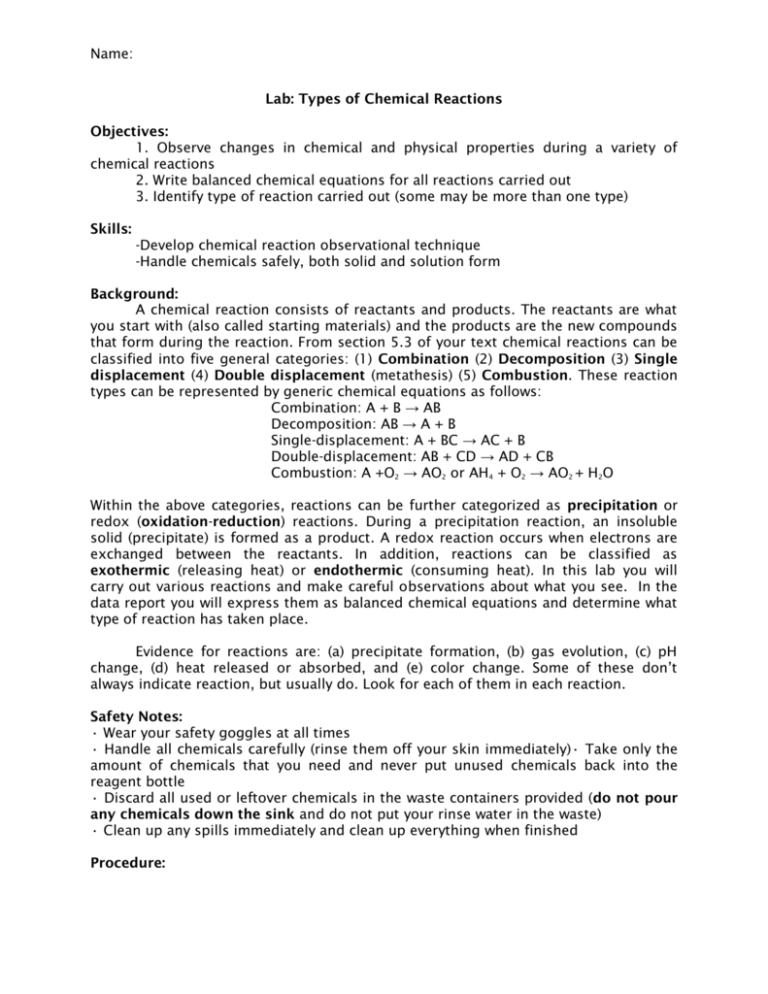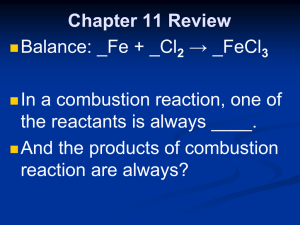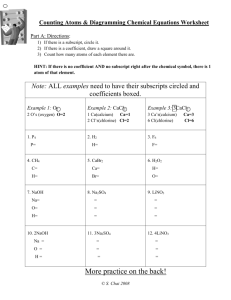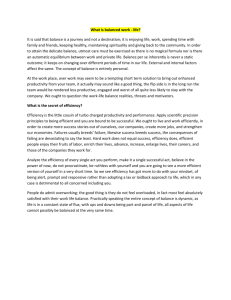rxn_types_lab
advertisement

Name: Lab: Types of Chemical Reactions Objectives: 1. Observe changes in chemical and physical properties during a variety of chemical reactions 2. Write balanced chemical equations for all reactions carried out 3. Identify type of reaction carried out (some may be more than one type) Skills: -Develop chemical reaction observational technique -Handle chemicals safely, both solid and solution form Background: A chemical reaction consists of reactants and products. The reactants are what you start with (also called starting materials) and the products are the new compounds that form during the reaction. From section 5.3 of your text chemical reactions can be classified into five general categories: (1) Combination (2) Decomposition (3) Single displacement (4) Double displacement (metathesis) (5) Combustion. These reaction types can be represented by generic chemical equations as follows: Combination: A + B → AB Decomposition: AB → A + B Single-displacement: A + BC → AC + B Double-displacement: AB + CD → AD + CB Combustion: A +O2 → AO2 or AH4 + O2 → AO2 + H2O Within the above categories, reactions can be further categorized as precipitation or redox (oxidation-reduction) reactions. During a precipitation reaction, an insoluble solid (precipitate) is formed as a product. A redox reaction occurs when electrons are exchanged between the reactants. In addition, reactions can be classified as exothermic (releasing heat) or endothermic (consuming heat). In this lab you will carry out various reactions and make careful observations about what you see. In the data report you will express them as balanced chemical equations and determine what type of reaction has taken place. Evidence for reactions are: (a) precipitate formation, (b) gas evolution, (c) pH change, (d) heat released or absorbed, and (e) color change. Some of these don’t always indicate reaction, but usually do. Look for each of them in each reaction. Safety Notes: • Wear your safety goggles at all times • Handle all chemicals carefully (rinse them off your skin immediately)• Take only the amount of chemicals that you need and never put unused chemicals back into the reagent bottle • Discard all used or leftover chemicals in the waste containers provided (do not pour any chemicals down the sink and do not put your rinse water in the waste) • Clean up any spills immediately and clean up everything when finished Procedure: Name: Carry out the following reactions. For each reaction, carefully write down all observations (color change, gas evolution, formation of a precipitate, or temperature change) below the appropriate reaction on the pages you created for the pre-lab. Your observations will be turned in and graded along with the data sheet. Use clean test tubes for the reactions. The reactions: Reaction 1: Magnesium combines with oxygen 1) Obtain a piece of magnesium. 2) Hold the magnesium with tongs, and place in the flame. BE CAREFUL NOT TO STARE AT THE REACTION. 3) The product should be placed in the solid waste container. 4) Record observations, write a complete balanced equation for the reaction, and label the reaction type. Reaction 2: Combination of carbon dioxide and water 1) Pour 50 ml of distilled water into an Erlenmeyer flask. 2) Add 3 drops of bromothymol blue indicator to the flask. 3) Use a straw to blow bubbles into the water indicator mixture. 4) Observe and record the color of the mixture. 5) Your reactants are water and carbon dioxide. What acidic product can you predict for this reaction? 6) Give a complete balanced equation for this reaction and name the reaction type. Reaction 3: Reaction of hydrogen peroxide with manganese (IV) oxide 1) Place 2 cm of hydrogen peroxide (H2O2) into a test tube. 2) Add a pinch of manganese (IV) oxide as a catalyst for the reaction (remember a catalyst is not used up in the reaction and is written above the arrow). 3) Test the gas that is being given off by placing a glowing splint into the tube. (Light a wooden splint, blow the flame out. If when you place the glowing splint into the tube the flame returns, the presence of oxygen is indicated.) 4) Record observations; write a complete balanced equation for this reaction, and name the reaction type. Reaction 4: Reaction of zinc and hydrochloric acid 1) Fill a test tube 1/4 full with HCl. (Use the 3M concentration) 2) Add a piece of zinc. 3) Test the gas given off for flammability by using a lit splint near the mouth of the test tube. 4) Record your observations, write a complete balanced equation for this reaction, and name the type of reaction observed. Reaction 5: Calcium carbonate reacts with hydrochloric acid 1) Place one small piece of chalk into a test tube. 2) Pour about 20 ml of 0.1M HCl into the test tube. Name: 3) Record your observations, write a complete balanced equation for your reaction and name the type of reaction observed. 4) Note the “acid” product in this reaction is unstable and breaks down to form carbon dioxide and water. 5) Rewrite your complete balanced equation showing these products. Reaction 6: The combustion of ethanol 1) Place 20 drops of ethanol C2H5OH onto a watch glass 2) Light a wooden splint and place it near the ethanol 3) Record your observations, write a complete balanced equation for this reaction, and list the reaction type observed. Data sheet Data: For each reaction, list all the evidence for reaction that you observed. For each reaction write the balanced chemical equation. For each reaction, list all types of reaction that apply. Reaction 1: Magnesium combines with oxygen Evidence of reaction (observations): Balanced chemical equation: Type (or types) of reaction: Reaction 2: Combination of carbon dioxide and water Evidence of reaction (observations): Balanced chemical equation: Type (or types) of reaction: Reaction 3: Reaction of hydrogen peroxide with manganese (IV) oxide Evidence of reaction (observations): Balanced chemical equation: Name: Type (or types) of reaction: Reaction 4: Reaction of zinc and hydrochloric acid Evidence of reaction (observations): Balanced chemical equation: Type (or types) of reaction: Reaction 5: Calcium carbonate reacts with hydrochloric acid Evidence of reaction (observations): Balanced chemical equation: Type (or types) of reaction: Reaction 6: The combustion of ethanol Evidence of reaction (observations): Balanced chemical equation: Type (or types) of reaction:







